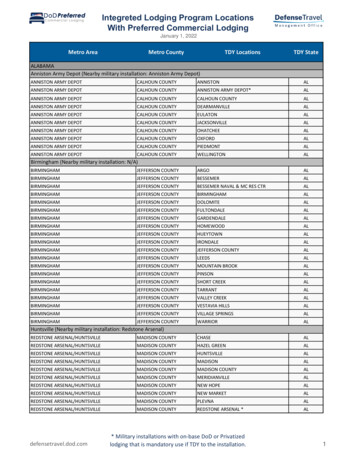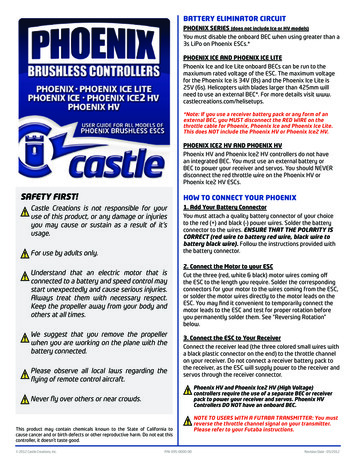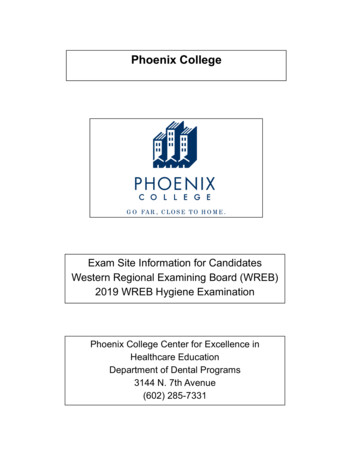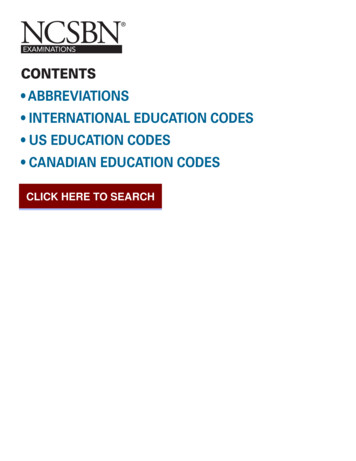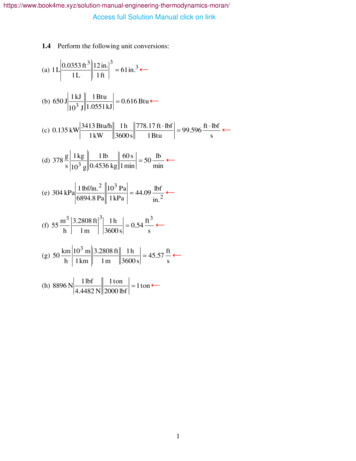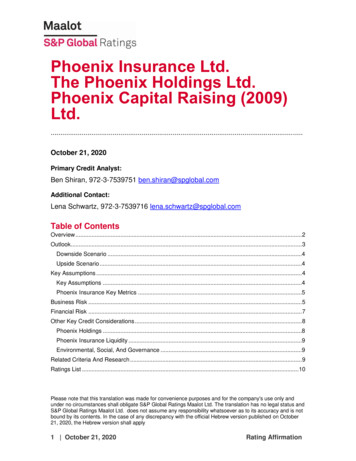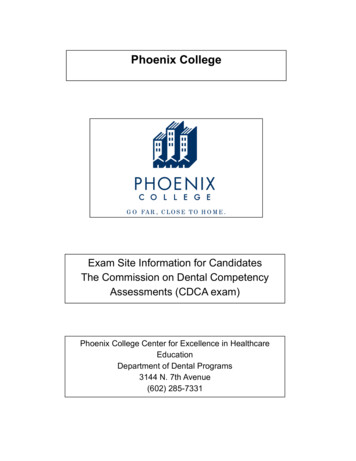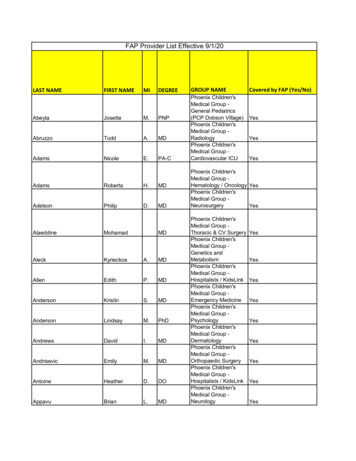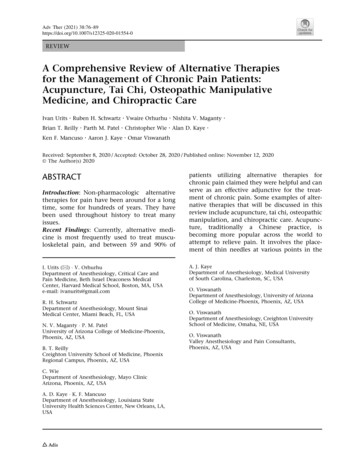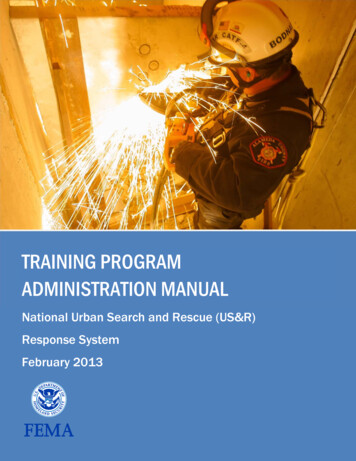
Transcription
TRAINING PROGRAMADMINISTRATION MANUALNational Urban Search and Rescue (US&R)Response SystemFebruary 2013
This page left blank intentionally
MANUAL 12-014NATIONAL URBAN SEARCH AND RESCUERESPONSE SYSTEMTRAINING PROGRAM ADMINISTRATION MANUALForewordThis administrative manual provides a guide for Department of Homeland Security(DHS)/Federal Emergency Management Agency (FEMA) personnel to train and maintainqualified personnel for the National Urban Search and Rescue (US&R) Response System.The National Urban Search and Rescue (US&R) Response System (the System) provides forthe coordination, development, and maintenance of the Federal effort with resources tolocate and extricate victims, provide immediate medical treatment to survivors trapped incollapsed structures, and conduct other life-saving operations.Questions, comments, and suggested improvements related to this document areencouraged. Inquiries, information, and requests for additional copies should be directed inwriting to the FEMA Office of Response and Recovery, Response Directorate, OperationsDivision, US&R Branch, Operations Section, 500 C Street SW, Washington, DC 20472.
This page left blank intentionallyii
Table of ContentsCHAPTER 1: INTRODUCTION . 11-1.Purpose . 11-2.Scope . 1CHAPTER 2: TASK FORCE TRAINING MANAGER - POSITION DESCRIPTION. 32-1.Functional Description . 32-2.Program Description. 32-3.Description of Duties . 3CHAPTER 3: FEMA US&R DIVISIONAL TRAINING WORK GROUP REPRESENTATIVES. 53-1.Position Description. 53-2.Description of Duties . 5CHAPTER 4: QUALITY ASSURANCE . 74-1.Instructor Continuing Education Units . 74-2.Instructor Code of Ethics . 7CHAPTER 5: TRAINING DELIVERY PROCEDURES . 115-1.Issue. 115-2.Policy. 115-3.Training & Exercise Types, Definitions And Conditions. 115-4.Training Equivalency Determination Process . 14CHAPTER 6: INSTRUCTOR CREDENTIALING . 176-1.Application Process . 176-2.Application Instructions . 176-3.Approval Process . 186-4.Instructor Change of Status . 186-5.FEMA US&R Adjunct Instructor Evaluation Form. 19CHAPTER 7: TASK FORCE TRAINING RECORDS . 217-1.Record Maintenance . 217-2.FEMA-Issued Course Numbers. 22APPENDIX A: TASK FORCE POSITION DESCRIPTIONS . 23 Complete IS-33.xx FEMA Ethics Orientation annually. (.xx- represents the current calendaryear version.) www.training.fema.gov/EMIWeb/IS . 24iii
Complete critical incident stress awareness training . 24CANINE SEARCH SPECIALIST. 25COMMUNICATIONS SPECIALIST . 27HAZARDOUS MATERIALS SPECIALIST . 29HAZARDOUS MATERIALS TEAM MANAGER . 33HEAVY EQUIPMENT AND RIGGING SPECIALIST . 35LOGISTICS SPECIALIST . 37LOGISTICS TEAM MANAGER. 39MEDICAL SPECIALIST . 41MEDICAL TEAM MANAGER . 43PLANNING TEAM MANAGER . 45RESCUE SPECIALIST . 47RESCUE SQUAD OFFICER . 49RESCUE TEAM MANAGER . 51SAFETY OFFICER . 53SEARCH TEAM MANAGER . 55STRUCTURES SPECIALIST. 59TASK FORCE LEADER. 61TECHNICAL INFORMATION SPECIALIST . 63TECHNICAL SEARCH SPECIALIST . 65WATER RESCUE SPECIALIST . 67APPENDIX B: INCIDENT SUPPORT TEAM POSITION DESCRIPTIONS . 69IST COMMUNICATIONS UNIT LEADER . 71IST DEMOBILIZATION UNIT LEADER . 73IST DIVISION/GROUP SUPERVISOR . 75IST DOCTOR OF VETERINARY MEDICINE . 77IST DOCUMENTATION UNIT LEADER . 79IST FACILITIES UNIT LEADER . 81IST GROUND SUPPORT UNIT LEADER . 83IST LEADER . 87IST LIAISON TO THE JOINT FIELD OFFICE . 89IST LOGISTICS SECTION CHIEF . 93IST OPERATIONS BRANCH DIRECTOR . 97IST OPERATIONS SECTION CHIEF . 99IST PLANNING SECTION CHIEF . 103iv
IST POA/MOBILIZATION CENTER SPECIALIST . 105IST INFORMATION OFFICER . 107IST RESOURCES UNIT LEADER . 109IST SAFETY OFFICER. 111IST SITUATION UNIT LEADER . 113IST STRUCTURES SPECIALIST . 115IST US&R SPECIALIST. 117IST TRAINING MATRIX. 119APPENDIX C: US&R TRAINING COURSE SITE REQUIREMENTS . 123APPENDIX D: TECHNICAL RESCUE SKILL SETS AND ADDITIONAL REQUIRED ROPE SKILLS. 127APPENDIX E: TRAINING-RELATED FORMS . 129FEMA Training Request Form . 131Instructor Change of Status Form . 135Instructor Application – Verification & Signature Form . 137New Course Checklist. 141APPENDIX F: CEU REQUIREMENTS BY DISCIPLINE . 143v
This page left blank intentionallyvi
NATIONAL US&R RESPONSE SYSTEMTRAINING PROGRAM ADMINISTRATION MANUALCHAPTER 1: INTRODUCTION1-1.Purpose1-2.The training of task force personnel is paramount to the overall preparedness of each taskforce, as well as the National US&R Response System as a whole. The standardizedadministration and management of task force training programs will ensure trainingrelated preparedness activities successfully transition to operational readinesscapabilities. This manual is provided to task forces to assist in the administration andmanagement of training and training related activities in order to maintain consistency forkey program elements throughout the entire National US&R Response System.ScopeThis manual is applicable to key elements of the Task Force Training Program, to include;types of training, criteria and approval processes, instructor credentialing, membercertification and records management. Additionally, the duties and responsibilities of theTask Force Training Manager, as well as those of the Divisional Training Work GroupRepresentatives are identified, including the interaction required of these individuals.It is the intent that this manual be referenced and utilized by Task Force Representatives,Task Force Program Managers, Task Force Training Managers and others involved withthe administration, management, coordination, delivery, evaluation and certificationprocesses of the Task Force Training Program.1
This page left blank intentionally2
CHAPTER 2: TASK FORCE TRAINING MANAGER - POSITION DESCRIPTION2-1.Functional Description2-2.To ensure each member of the task force is properly trained to conduct his or her duties aspart of the FEMA US&R Position Description, and that, as a whole, the task force can fulfillits intended mission.2-3.Training needs to be an on-going cycle of activities which prepares individuals, functionalteams, and the entire task force for their specific roles and tasks as required at the time ofmobilization, deployment, on-site operations, de-mobilization, and return-to-readiness.This requires that the Training Manager work closely with the team managers tounderstand their training needs and priorities. The Training Manager must keep abreast ofall scheduled FEMA-sponsored courses and through the team managers, submitapplications for the eligible candidates. The Training Manager shall plan and coordinatetask force participation in disaster training and exercises at the Local, State, and Federallevels.I.Program DescriptionDescription of DutiesA position created to manage all training-related activities of the task force.General ResponsibilitiesResponsible for assisting the task force in accomplishing program development andreadiness objectives that relate to education, training and exercises by:A. Establishing training priorities based on the needs of the task forceB. Coordinating with the Program Manager, task force leaders and team managersdeveloping an annual training calendar and budgetinC. Assisting team managers with the development of lesson plans, announcements, andtraining plans.D. Maintaining a master record of training on all members of the task forceE. Maintaining communications with the divisional training work group representativeF. Ensuring that all updated FEMA curriculum materials are forwarded to task forceinstructors3
II.G. Complete HSEEP training requirements as outlined in the strategic training plan and,where appropriate, utilize and plan TF training activities through its useSpecific ResponsibilitiesA. Provide to FEMA on an annual basis, copies of task force personnel roster and certify theirlevel of training or position qualifications.B. Ensure training and exercise activities of the task force meet FEMA’s specifications,requirements and certifications.C. Coordinate training of task force members to perform US&R duties in accordance withestablished FEMA Position Descriptions following guidelines identified in the Position TaskBook Administrator’s Guide.D. Ensure that partial or full-scale US&R exercises and drills, including mobilization drills areconducted.E. Assure delivery of US&R related training courses for task force personnel, includingdevelopment and delivery of local US&R training courses.F. Maintain accurate training records for all task force members and ensure that they are keptup to date.G. Develop an annual training plan to address the training needs of all aspects of the taskforce.H. Annually review and verify task force FEMA approved instructor list.4
CHAPTER 3: FEMA US&R DIVISIONAL TRAINING WORK GROUP REPRESENTATIVES3-1.Position Description3-2.The position of Divisional Training Work Group Representative is intended to enhancecommunications and improve training needs from the task force level to the FEMA US&RProgram Office via the Training Work Group. These positions are appointed by the WorkGroup Chair with mutual agreement of the appointed member.Description of DutiesA FEMA US&R Divisional Training Work Group Representative is responsible for thefollowing: Coordinating communications among task force training managers within specifiedregion Updating, advising, and coordinating the following: Course request screening process and routing from task forces Instructor applications screening process within region Collaborating with task force training managers to field questions and concernsrelating to training at all levels Attending training work group meetings as scheduled Attending divisional Task Force Leader meetings to update and advise leaders ofcurrent training program direction Communicating with FEMA US&R Program Office to assist and advise on trainingissues Providing guidance to the Task Force Training Manager on the use of the FEMATraining Program Administration Manual5
This page left blank intentionally6
CHAPTER 4: QUALITY ASSURANCE4-1.Instructor Continuing Education UnitsFEMA US&R supports training for all of the FEMA US&R task forces. In many instances,instructors from other task forces are utilized to facilitate training. To keep instruction atthe highest level, there is a need for a Continuing Education Units program.Looking at the FEMA US&R Training Work Group model for qualifying instructors, it isapparent that there is a good initial screening for instructor qualifications. However, oncean instructor’s certificate is issued, there is no mechanism to ensure the instructor iscompetent, staying abreast of current subject matter, nor actively teaching. Also, there areno guidelines for the span of time between classes taught by an instructor.If FEMA is to ensure the proficiency of National US&R Response System instructors, whichin turn reflects directly on the level of instruction, FEMA staff will need to monitor theSystem’s instructors.The purpose of the CEUs system will be to encourage instructors to stay abreast of currenttrends, knowledge and information. Another benefit of a CEUs program is that instructorswould attain and maintain a higher level of professionalism. This would further enhancethe reputation of the National US&R Response System instructors and courses.Many professional organizations, teachers and other disciplines are required to completeCEUs to maintain certification. These classes are for the exchange of ideas and update ofcurrent issues and would help insure that the FEMA US&R instructors would wear a badgeof professionalism and the classes they teach would be of the highest caliber.4-2.Approved CEU requirements as per each individual Work Group will be maintained inAppendix F.I.It is the responsibility of the Task Force Training Manager to ensure that all FEMA US&Rcredentialed instructors follow the code of ethics listed below.Instructor Code of EthicsPRINCIPLE I – Commitment to the StudentThe instructor strives to help students realize their potential as an effective member of theNational US&R Response System. The instructor works to enhance the learningenvironment and the acquisition of knowledge.In fulfillment of the obligation to the student, the instructor shall do the following: Create a positive learning environment for the students7
Encourage students to think and act independently in their pursuit of learning Encourage critical thinking and expression of varying points of view Make reasonable effort to protect the student from physical conditions harmful tolearning or to health and safety Never be under the influence of illicit drugs or alcohol during any portion of a class Foster and support the diversity each student brings to the classroom Treat student with equal respect and provide equal opportunities Establish and maintain the student/instructor professional relationship Refrain from rrassmentor Promote an environment free of inappropriate racial, ethnic, religious, political, orsexual comments Refrain from the use of profane or abusive language Maintain each student’s right to privacy and confidentiality Make every effort to impart knowledge relevant to student’s successII. Encourage a safe, non-hostile harassment free teaching/working environmentincluding any “hazing” type actionsPRINCIPLE II - Commitment to Training and EducationTraining and Education is vested by the National US&R Response System with a trust andresponsibility requiring the highest ideals of professional service. In fulfillment of theobligation to the System, the instructor shall do the following: Maintain honesty above reproach when presenting the instructor’s qualifications byproviding only accurate information Maintain classroom integrity by allowing only credentialed instructors to teach Maintain professional integrity by refusing any gratuity and/or gift that mightappear to influence professional decisions or actions Adhere to provisions of 5 CFR 2635.807 in all aspects of teaching, speaking, andwriting8
III.PRINCIPLE III - Commitment to FEMA US&R TrainingIn the belief that the quality of services delivered directly influences the program, theinstructor shall make every effort to raise professional standards, and to promote a climatethat encourages the enhancement of the National US&R Response System mission.In fulfillment of the obligation to the mission, the instructor shall adhere to the following: Maintain exam integrity by not distributing them for student review Teach the course to meet the course goals and objectives set by the National US&RResponse System Administer the certification exam under direct visual supervision Adhere to the policies and procedures of the FEMA US&R Training Program Monitor student attendance daily and document the approval of any absences Keep current on the topics they are credentialed to teach Adhere to all copyright laws Meet all course content requirements Use the course material identified by the National US&R Response System asrequired for the course Ensure that the student/instructor ratio is maintained at all times Inform the appropriate FEMA US&R regional training representative on any issuesfound within the course curriculum or delivery Report to FEMA US&R regional training representative information regardingclasses and/or instructors that do not meet the standards required by the FEMAUS&R program Teach only a class or portion of a class for which they are credentialed Report to FEMA US&R training work group any negative or harmful classroomdynamics that occurred during the delivery of a FEMA US&R class Refrain from making false or malicious statements about FEMA US&R trainingcourses and/or instructors Support the mission of the National US&R Response System at all times9
This page left blank intentionally10
CHAPTER 5: TRAINING DELIVERY PROCEDURES5-1.Issue5-2.Training and exercises are critical to National US&R Response System preparedness.National policy is needed to clarify US&R training and exercise-related terminology, thetypes of training delivery available and procedures for requesting, approving andcertifying completion of training and exercises that meet established standards andrequirements of the National US&R Response System.PolicyThe National US&R Response System implements the policy and procedures for trainingand exercises supporting the National US&R mission set forth in this procedure. Thefollowing four types of training and exercises are addressed and defined herein:1.2.3.4.FEMA-sponsored training and exercisesFEMA-sanctioned training and exercisesFEMA-equivalent trainingFEMA-authorized trainingThe intent of this policy is to support the current preparedness requirements of theNational US&R Response System to meet mission response requirements. This missionhas evolved over time and is expected to continue to do so in the future. As the missionhas changed, so have the training and exercise requirements to safely perform the mission.Specific training requirements are best described within the approved PositionDescriptions for National US&R Response System members. These position descriptionscan be found in Appendix A of this manual. A mechanism for updating position descriptiontraining and qualifications requirements exists within the National US&R AdvisoryOrganization process. There may be a need from time to time to supplement thisestablished process with other FEMA direction to address a changed mission or urgent andcompelling need.5-3.This policy is fully in accordance with the cost neutrality principles on which the proposedrule governing the National US&R Response System is based, 44 CFR 208. Therefore,expenditure of FEMA US&R Preparedness funds for purposes other than those that directlysupport FEMA National US&R training and exercise requirements is not permitted.Training & Exercise Types, Definitions And ConditionsAll training must be delivered in accordance with FEMA US&R program directive 2004001.11
I.FEMA-Sponsored Training And ExercisesThese exercises use approved national standard curricula andprocedure and areprovided, paid for, and directly controlled by FEMA through contract, interagencyagreement or other method of acquisition. Training and exercises are hosted at various appropriate locations throughout theUS. Instructors are identified, certified, approved and paid for by FEMA. National US&R Response System members are covered by the Federal WorkersCompensation Program authorized by the Federal Employees Compensation Act. Certificates are issued by FEMA for successful completion. Federal funds provided by FEMA through US&R Readiness Cooperative Agreementsmay be used for the participation of National US&R Response System members tosupplement FEMA paid costs (e.g., approved additional training participants). National US&R Response System members are not currently covered by the FederalTort Claims Act.II. Example: National US&R Task Force Leaders Course.FEMA-Sanctioned Training And ExercisesThese exercises use approved national standard curricula and procedure and are hosted,sponsored, provided and directly controlled by a National US&R Task Force SponsoringAgency. Completion of this training or exercise is an identified requirement in an approvedPosition Description contained in the FEMA US&R Operations Manual or other FEMAdirection. The training program manager for each task force shall ensure a FEMA coursenumber has been issued by the program office and is attached or visible on the issuedcertificates. Training and exercises are hosted at various appropriate locations throughout theUS. Instructors are identified, certified, approved by FEMA and paid for by theSponsoring Agency (Federal funds may be used). National US&R Response System members are covered by the Federal WorkersCompensation Program authorized by the Federal Employees Compensation Act. Certificates are issued by the Sponsoring Agency for successful completion. Federal funds provided by FEMA through US&R Readiness Cooperative Agreementsmay be used for course preparation, delivery and the participation of National US&RResponse System members.12
National US&R Response System members are not currently covered by the FederalTort Claims Act.III. Example: National US&R Rescue Specialist courseFEMA-Equivalent TrainingThis training is non-system training officially determined by FEMA to be functionallyequivalent to training delivered as FEMA Sponsored training, or task forces training at thelocal level Such training is hosted, sponsored and may be provided by someone otherthan FEMA (e.g. Industry Standards or Professional Associations) and does not meet thedefinition of FEMA Sanctioned Training. Completion of this training or a specificallydetermined equivalent portion of it is an identified requirement in an approved PositionDescription contained in the FEMA US&R Operations Manual or other FEMA direction.The training program manager for each task force shall ensure a FEMA course numberhas been issued by the program office and is attached or visible on the issued certificates. Training is hosted at various appropriate locations throughout the US. Instructors are determined by FEMA to meet or exceed minimum qualificationstandards established by the National US&R Response System. National US&R Response System members are not covered by the Federal WorkersCompensation Program. Certificates of completion are issued by the training sponsor. FEMA will accept suchcertificates as evidence of fulfillment of training requirements provided that anofficial FEMA Equivalency Determination is offered to support such claim. Federal funds provided by FEMA through US&R Readiness Cooperative Agreementsmay be used for course preparation, delivery and the participation of National US&RResponse System members to the extent that these funds are used to supportNational US&R Response System requirements. The Federal Tort Claims Act does not cover National US&R Response Systemmembers.IV. Example: DOJ WMD Basic Concepts.FEMA-Authorized TrainingThis training has no established curricula but the knowledge, skills and abilities gainedfrom the training are specifically required in the National US&R Operations ManualPosition Descriptions (e.g., NWCG ICS courses). Such training may be hosted, sponsoredand provided by someone other than FEMA. FEMA exerts no direct control of the curriculaor its delivery. The training program manager for each task force shall ensure a FEMAcourse number has been issued by the program office when applicable and is attached orvisible on the issued certificates.13
Training is hosted at various appropriate locations throughout the US. National US&R Response System members are not covered by the Fed
administration and management of task force training programs will ensure training related preparedness activities successfully transition to operational readiness capabilities. This manual is provided to task forces to assist in the administration and management of training and training related activities in order to maintain consistency for
